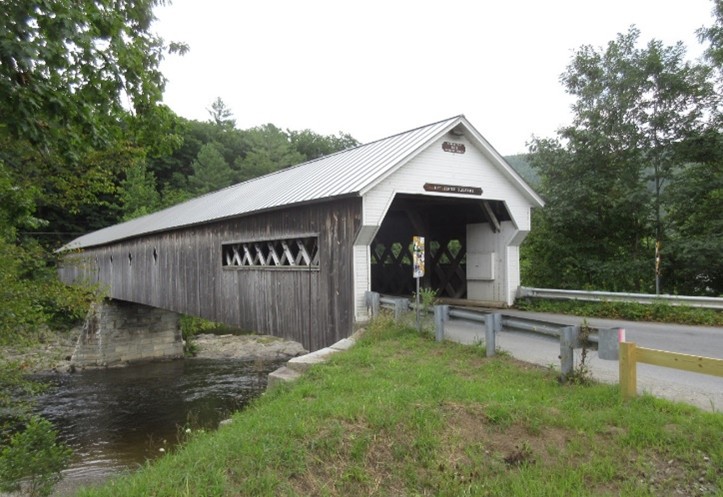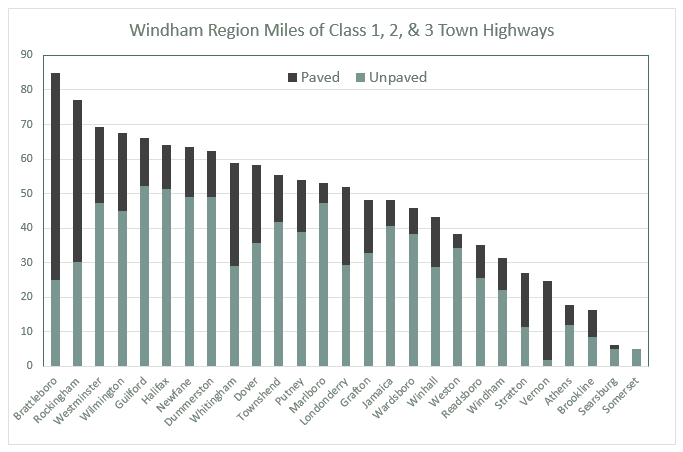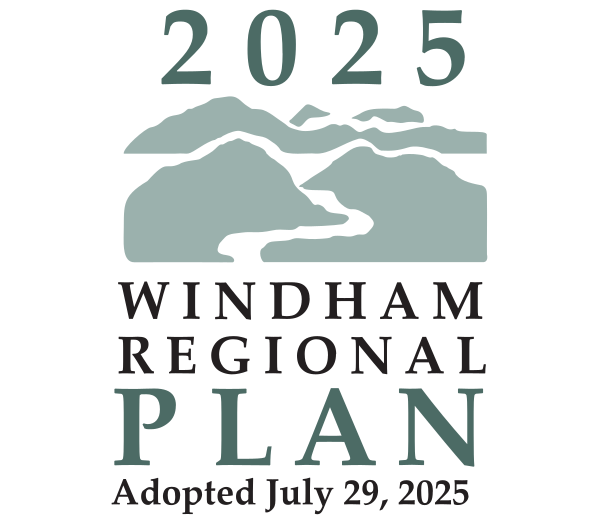Transportation
Highways and Bridges
There are approximately 1,700 miles of roads in the Windham Region, ranging from the limited access highway Interstate-91, which averages more than 20,000 vehicles per day at its busiest section in the region, to unmaintained, impassable class 4 town highways, which see few, if any, vehicles on any given day. Town highways are the primary transportation system in the region, carrying thousands of residents, visitors, commuters and others to and from important destinations each day. Town highways also represent the largest expense for most communities in the region and rising costs for road materials and paving represent a significant challenge for our communities. Ensuring that town highways are properly constructed and sufficiently maintained to accommodate traffic volumes is critical to the overall vitality of the Windham Region.

Photo Credit: WRC
In addition to the town’s local highway budget, the VTrans Town Highway State Aid provides substantial funding for towns to maintain and improve their transportation infrastructure in accordance with 19 V.S.A. § 306(a). Towns are paid quarterly by the State depending on their total town highway mileage and no application or local match is required. The only stipulation is that State Aid highways funds are used solely for town highway construction, improvement, and maintenance purposes, and that towns expend no less than $300 per road mile. These rates vary based on roadway class, with Class 1 town highways receiving the highest allocation per mile and Class 3 the lowest. As of 2023 the current per mile town highway State Aid rate for Class 1 is $13,365.59, for Class 2 is $4,916.01, and for Class 3 is $1,825.45. This is a critical source of funding for towns to ensure that our transportation system can continue to function at a level adequate to meet the needs of the region.
Town Highway Classification
Town Highways in Vermont are divided into four classifications as described below, based primarily on the condition of the roadway and daily traffic volumes:
- Class 1: Class 1 town highways are sections of numbered state highways that are owned and maintained by municipalities. They are town generally a short section of town owned roadway within a larger section of the state highway, often in a village or urban setting. There are clearly defined boundaries for state and town responsibility.
- Class 2: Class 2 town highways are generally the most important local roads. They often handle the largest volume of daily traffic and provide the primary connection between towns or villages. Class 2 town highways are often but not always paved and the proportion of paved or unpaved town highways varies greatly between towns in the region.
- Class 3: Class 3 town highways represent the largest total number of road miles in the region. These are the majority of roads in a community, generally all local roads that do not serve as major connections between towns and villages. The State of Vermont requires that Class 3 roads must be “negotiable under normal conditions all seasons of the year by a standard manufactured pleasure car” and “should be plowed and made negotiable during the winter”. Class 3 town highways are often unpaved in rural areas, while most are paved in or near villages and urban areas.
- Class 4: There are no minimum maintenance requirements for Class 4 town highways. Most towns do not maintain Class 4 town highways, though maintenance is at the discretion of the municipality. Some Class 4 town highways are maintained by local residents and provide access to homes and camps. Other Class 4 town highways may be passable only to high clearance/four wheel drive vehicles, or abandoned and completely impassable.
The chart below shows the total miles of paved and unpaved Class 1, 2, and 3 town highways in each municipality in the Windham Region. Approximately 83% of Class 2 town highways are paved, as compared to only 19% of Class 3 town highways. For most communities outside of the larger towns of Brattleboro and Rockingham, the total mileage of unpaved roads is significantly greater than paved roads, although there are exceptions, such as Whitingham, Stratton, and Vernon.

Class 1 Highways
Class 1 roads in the Windham Region are concentrated in our two largest communities, Brattleboro and Rockingham, comprising of short sections of Route 5 through Downtown Brattleboro and the Village of Bellows Falls, Route 9 in Brattleboro from the intersection with Main Street to West Brattleboro, and a short section of Route 100 in Readsboro. Class 1 town highways give towns greater control and flexibility of state highways in their downtowns and villages, allowing towns to set speed limits, site crosswalks, build and maintain infrastructure such as sidewalks, bike lanes, or implement traffic calming techniques without the approval process required for VTrans-owned and maintained highways.
Any potential reclassification of State Highways to Class 1 town highways needs to be carefully considered. There are significant potential benefits for towns to take control of state highways within their downtowns and villages centers. Reclassifying to Class 1 gives towns more autonomy to make decisions on important transportation issues that impact a communities’ most important civic, commercial, and cultural centers. Reclassification of state highways does, however, increase local highway maintenance costs, as state highways in downtowns and villages are often the most heavily trafficked sections of roadway within a town.
VTrans is expected to issue updated guidance on reclassification of Class 1 town highways, as well as update design standards on state highways within villages and downtowns, by 2025. The Windham Regional Commission will provide support to municipalities when considering the reclassification of state highways to Class 1 in our downtowns and villages and planning support in accordance with the updated VTrans guidance and design standards once they are issued.
Class 2 and 3 Highways
The vast majority of roads in the Windham Region are Class 2 and Class 3 town highways. These are the roadways which move the majority of good and people throughout the region and the safe and effective function of Class 2 and 3 town highways is critical to social, cultural and economic life in the region.
Class 2 town highways may be paved or unpaved and the proportion of paved or unpaved town highways varies greatly between towns in the region. Gravel and dirt roads contribute greatly to the region’s rural character and charm, but can also present greater maintenance challenges for towns during winter and mud season as discussed in the Transportation Resiliency section. It is a difficult decision for Selectboards whether or not to pave a road in their town. Paving unpaved roads is a substantial expense for most towns and gravel roads can be significantly less expensive to maintain, but factors such as volume and type of traffic, and existence of steep grades, may outweigh the lower maintenance costs. Gravel roads are more prone to erosion and wash out during high water events which can significantly increase costs as well as greatly impair overall transportation connectivity during severe storms. These factors must be carefully weighed and addressed in both the context of the specific needs of the town and the greater character and atmosphere of the Region.
The Class 2 Town Highway Paving Program is the primary funding source for towns to pave currently unpaved or to resurface existing paved Class 2 town highways. This funding is limited to a total sum of $200,000 and is allocated annually by the VTrans District based on a formula that accounts for a variety of factors including Class 2 town highway miles as well as how recently a town has received funding. Towns must apply to their VTrans District, in the Windham Region either District 1 or District 2 depending on the town, and the funding requires a 30% local match, reduced to 20% if the town has adopted road and bridge standards that meet the minimum state requirements.
Class 3 town highways represent the largest total number of road miles in the Windham Region. Class 3 highways are generally unpaved, primarily rural and residential in character, but also provide important connections for agriculture, logging, and other industries in the region’s resource economy. Constructing and maintaining Class 3 highways with a proper sub base and drainage is important to the overall functionality of the transportation system and the Windham Regional Commission will continue to work with towns on implementing best practices on gravel road construction and maintenance around the region.
Class 4 Highways and Legal Trails
Class 4 town highways and legal town trails are a small part of the region’s overall road network, comprising 119.8 and 42.7 total road miles, respectively. Increasingly, the Windham Region has seen residential development taking place on Class 4 town highways. This development can create potential issues for municipalities where increased traffic volumes due to new development exceed the reasonable capacity of a Class 4 town highway. It is important that towns maintain clear policies on local maintenance limitations, as well as municipal versus property owner responsibilities for both the maintenance and reclassification of Class 4 town highways.
Legal Trails and Class 4 town highways can also provide significant opportunities for recreational use for hikers, bicyclists, and snowmobiles, and are often underutilized in this capacity across the region. The Windham Regional Commission supports planning and implementation for towns to examine how Class 4 town highways and legal town trails may fit into the larger trail and recreation network in their community and where opportunities may exist to encourage greater recreational use of such facilities and improve integration into the larger regional trail network.
BRIDGES
Bridges are critical pieces of the larger regional highway system, vital to the overall function of the transportation network in the Windham Region. Bridges are the most expensive and difficult transportation infrastructure for towns to maintain and replace. Towns are largely dependent on state funding to ensure that our region’s bridges can continue to handle the daily traffic loads necessary to ensure the efficient function of the transportation network. Aging bridge infrastructure is a major challenge for our region and across Vermont. As of 2023, VTrans has identified 1,250 bridges across the state in need of repair, equal to 44% of all bridges in the State. The vast majority of these bridges are owned and maintained by municipalities, and ensuring that all bridges in need of repair are identified and addressed in a timely manner is critical to the continued functioning of our transportation network.

Photo Credit: WRC
Bridge replacement and repair projects are expensive and substantial construction cost increases in the past few years have put a strain on our ability to meet state and local infrastructure needs. The Vermont 2022-2025 State Transportation Improvement Program allocated funding for 32 town highway bridges across the state, including 8 in the Windham Region, totaling nearly $105 million in total cost. These 8 bridges represent just a small fraction of those in the Windham Region in need of repair. The Town Highway Bridge program is the primary source of funding for bridge replacement and repair projects for towns in the Windham Region. It is critical that we advocate for our town highway bridges to be prioritized and addressed in a timely manner whenever possible. Furthermore, the Windham Regional Commission will continue to work with towns on identifying and accessing funding for bridge replacement projects beyond the VTrans bridge program. This includes a variety of direct Federal grant programs, as well as funding from the Northern Borders Regional Commission.
The smallest, most resource-limited towns in the Region are in a particularly difficult position in securing funding to replace aging bridge infrastructure. Agency of Transportation funding formulas use a variety of criteria to prioritize local bridge projects, and funding is prioritized for bridges on more heavily trafficked sections of road in larger, generally more well-resourced, communities. It is difficult for our smallest towns to be competitive in this process and they often have no choice other than to continue to spend large amounts of their municipal budget on patchwork bridge repairs that do not provide lasting solutions for their aging bridge infrastructure. The Windham Regional Commission will continue to advocate for more equitable distribution of bridge funding that ensures that our small, rural towns are not forgotten during the state and federal infrastructure funding decision making process.
